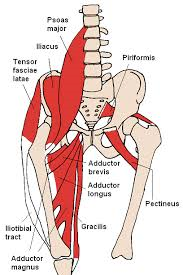We hear a lot about the quads and the hamstrings so its surprising the adductors are not so well known. Size-wise, they are larger than the hamstrings and nearly as large as the quadriceps. They are a group of five muscles (adductor magnus, adductor brevis, adductor longus, gracilis and pectineus) that originate on the public bone or the ishial tuberosities (sit bones) and insert at the femur and, in the case of the longest adductor, the gracilis, at the upper tibia (shin bone).
Together with the abductors, another set of muscles in the outer hips and buttocks (gluteus medius, gluteus minimus and tensor fasciae latae), they stabilize the leg and pelvis permitting us to stand, balance and walk. The adductors function to pull the thighs together, while the opposing abductors lift the leg out to the side. How do you keep the actions of these two muscle groups straight? Think “add” (bring together) and “abduct” (take away).
Imbalances may occur with any combination of these muscle groups: weak/strong; tight/flexible. A typical imbalance occurs when the adductors are tight and the abductors are weak. One cause of this may be sitting for an extended period, especially if the legs are crossed. When groin muscles are tight and the gluteus medius is weak, it might manifest in difficulties with walking and balance, hip pain while lying on one’s side at night or joint deterioration. Another common form of imbalance occurs when the adductors are weak but the abductors are relatively strong.
Balancing the strength and flexibility in these muscle groups will help prevent injury and bring greater awareness of the functioning of the legs, hips joints and pelvis. Fortunately, yoga gives us the tools for this.

